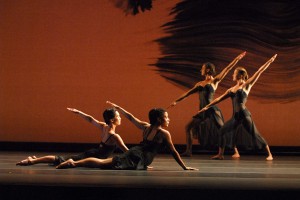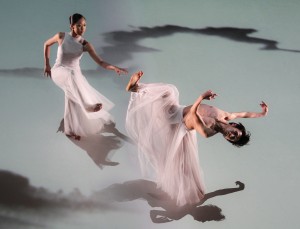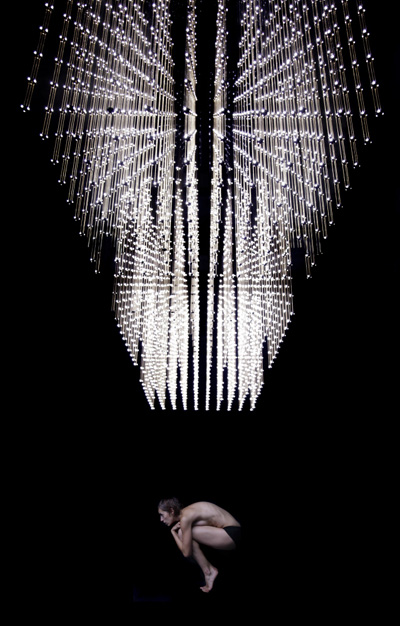11/12 Dance Series
The UMS Dance Series includes four events in Ann Arbor’s Power Center. The series begins with the Mark Morris Dance group performing two nights of new repertory. Two companies make their UMS debuts: Taiwan’s Cloud Gate Dance Theatre with Water Stains on the Wall and Random Dance, a company started by Wayne McGregor, whose groundbreaking collaborations across dance, film, music, visual art, and science are evident in the company’s presentation of FAR. Finally, Ballet Preljocaj’s production of Snow White, set to music by Gustav Mahler and featuring costumes by Jean Paul Gaultier, closes the dance season.
Subscription packages go on sale to the general public on Monday, May 9, and will be available through Friday, September 17. Current subscribers will receive renewal packets in early May and may renew their series upon receipt of the packet. Tickets to individual events will go on sale to the general public on Monday, August 22 (via www.ums.org) and Wednesday, August 24 (in person and by phone). Not sure if you’re on our mailing list? Click here to update your mailing address to be sure you’ll receive a brochure.
Mark Morris Dance Group
Friday & Saturday, September 23 & 24, 8 pm
Power Center
Mark Morris has changed the way that audiences see modern dance, with unique artistry that reflects a profound and sophisticated love of music. His company of exuberant dancers lives up to its reputation of wit, grace, and a refined musicality that is further reinforced by Morris’s use of live musicians in every performance. These two performances feature new Morris repertoire.

Program
Excursions (Barber’s Excursions for Piano, Op. 20)
Festival Dance (Hummel Piano Quartet)
Socrates (Erik Satie’s Socrates for tenor and piano)
Water Stains on the Wall
Cloud Gate Dance Theatre
Lin Hwai-min, artistic director
Friday, October 21, 8pm
Saturday, October 22, 8pm
Power Center
Trained in tai chi, meditation, Chinese opera movement, modern dance, and ballet, Cloud Gate Dance Theatre performs a rich repertoire with roots in Asian myths, folklore, and aesthetics, all infused with a contemporary perspective. For this long-awaited UMS debut, Cloud Gate presents Hwai-min’s newest work, Water Stains on the Wall. “Water stains on the wall” is a popular metaphor that represents the highest state in the aesthetics of Chinese calligraphy. Hwai-min and dancers take off from this metaphor and create and abstract work of beauty and magic that stands sublimely on its own.
FAR
Random Dance
Wayne McGregor, artistic director
Friday, February 17, 8 pm
Power Center
Random Dance was founded in 1992 and became the instrument upon which Wayne McGregor evolved his drastically fast and articulate choreographic style. The company became a byword for its radical approach to new technology, incorporating animation, digital film, 3D architecture, electronic sound, and virtual dancers into the live choreography. In FAR, cutting edge design is fused with choreography made from a radical cognitive research process. FAR “talks about the Enlightenment’s fascination with the working of the mind and the dissection of the body…draw[ing] to a close with…the utmost tenderness and finality.” (The Times, London)
Snow White
Ballet Preljocaj
Angelin Preljocaj, artistic director
Thursday, April 19, 7:30 pm
Friday, April 20, 8 pm
Saturday, April 21, 8 pm
Power Center
After more than a decade since its UMS debut, Ballet Preljocaj (pronounced prezh-oh-kahzh) returns with its production of Snow White. Angelin Preljocaj has created a work for all 26 dancers of his company, setting the Grimm brothers’ version of the fairytale to the most beautiful scores of Gustav Mahler’s symphonies for this romantic contemporary ballet. With costumes designed by Jean Paul Gaultier, this production of Snow White is sure to shake up those who have grown up with only the Disney version at their disposal.
Return to the complete chronological list.
Hubbard Street Dance Chicago: Your Questions Answered!
Editor’s note: Hubbard Street Dance Chicago return to Ann Arbor on October 27, 2015.
To close out this season’s Dance Series, we had three mesmerizing performances by Hubbard Street Dance Chicago on April 22-24. For a long time, members of our staff had wanted to try out the concept of a “post-it wall” in the lobby for a performance. We thought it would be interesting to try this with a dance company because dance can inspire so many different feelings, interpretations, and questions.
Throughout the weekend, Company dancers and touring staff loved seeing your comments on the wall (as did other audience patrons and we)! There were three different opportunities to respond:
-Describe tonight in six words or less.
-What was your favorite piece?
-Leave a question for the Company.
Glenn Edgerton, Hubbard Street Dance Chicago’s Artistic Director, was kind enough to answer all the questions you left on the wall. Thanks, Glenn!
Last dance (Walking Mad): why not end on the high note? The slow piece at the end wore the audience down…you could have had a standing ovation without the slower dance.
Often choreographers like to contrast their work and basically “keep it real”. Once they give you that feeling of excitement and euphoria their thought process is to bring you back down to reality and emotionally give you one last profound statement to contemplate.
If you are sad during a performance do you have to smile?
As a dancer, you also have to be an actor. If the part requires a smile, then yes you have to be able to perform the work with the emotional content as it is intended.
Did another company perform Bitter Suite? Sounds familiar.
Jorma Elo has also made a work for Aspen Santa Fe Ballet called “Red Suite” but not sure if they ever performed in Ann Arbor. (UMS Note: Neither of these works have ever been performed under UMS auspices.)
Was the volume to the music for Walking Mad turned down on purpose? Why?
Yes, the music volume gets turned down to create the image of the music coming from another part of a house or space. Just prior to this moment the dancers are with party hats and dancing through the doorway evoking a party scene. Once they pass through, the space changes and traps the female dancer in another space and then the music is meant to seem like it is coming from a distance from where the party is happening on the other side of the wall.
Is this the only theater you perform at where the audience posts questions?
Yes, this was a unique idea of UMS.
How many times a week do you practice?
We rehearse five days a week. When there are performances however this might turn into six days a week.
How do you synchronize so accurately when the music is so nondescript from measure to measure?
Practice, practice, practice. But actually, once you work with music for a while it starts to become more apparent where the landmarks are at least.
When you turn off your cameras and cell phones during the performances how do the photographers get pictures for the brochure?
We have individual agreements with photographers to get pictures during technical rehearsals and sometimes in performances; consequently they are the only ones with the rights to keep their cameras turned on.
How many shows did you perform so far?
In Ann Arbor we had four performances in total—one was a school show.
Why not have the choreographers explain what they are trying to express?
The idea is to have your imagination cultivated during the performance and to find the expression that fits for you and your life.
Which dance was your favorite to perform, and why?
Since I am the artistic director I can’t answer that for the dancers but I know from my past and know from our current dancers, typically the most challenging work, physically and emotionally, becomes a dancer’s favorite; although as a director they are all supposed to be equally important.
Why not have a more descriptive breakdown of each program included in your guide?
This is a similar question from before; the description should be your description and not told to you but rather for you to create and imagine.
Why did you choose to portray violence?
If that is your image from what you saw that is certainly valid. I can’t imagine however, you thought it was all violent. We always try to show a wide range of emotions and physicality in one evening.
Are you all friends?
Yes, we are all friends. As with any group you are often closer to some than others but everyone gets along very well with each other.
Are your bows choreographed as part of the dance?
Bows are often the last thing to be rehearsed but yes they are planned.
How many weeks does it take to learn a piece?
Learning a piece and creating a piece are two different things. To learn a piece already existing can take as little as two weeks to four. Creating a new work for a third of an evening (approx. 25 min) usually takes four to five weeks.
How old were you when you started taking dance lessons?
Me personally, I was six. Each dancer has a different past and process to their dancing career.
How long have most of you been dancing?
Most of our dancers started at a young age, typically around eleven, but occasionally you will see a dancer who started at four and others who started at eighteen.
Do you struggle with injuries?
Injuries are an unfortunate reality to being a dancer. You are always trying to go further with your movements to increase your range of movement and dynamic qualities therefore strength issues and structural issues become a definite struggle.
Dude, wasn’t it awkward to have your family see you topless and still convince them you’re not that kind of dancer? –>Are you an idiot?
This was a two part comment. The subsequent post-it, asking the other messenger if he was an idiot, drew an arrow to the first question. I actually have strong opinions about both of these statements. Even the word topless makes me cringe. That part of the piece was meant to express vulnerability and a nakedness of raw emotion, not to be gratuitous or sexual in any way. The men did not wear shirts for the entire piece and therefore this moment when the woman doesn’t either, evokes a sense of equality and a double standard of nudity in our society. The second statement is a judgment that also makes me cringe. Each individual has their interpretation of the experience which I would hope is respected although I encourage each audience member to go deeper into his thoughts to find an aspect that makes him see beyond the obvious.
Do you eat fish?
I’m assuming this is a comment from a piece we have had in the repertory in the past called “Minus 16” where one of the dancers has spoken text, which he asks, “Do you eat fish?”
Is the chemistry between partners difficult to foster or does it come naturally?
Sometimes as a director you get an immediate sense of who will have chemistry with another and then there are other times surprises come forward in a very holistic way; each pairing is different.
How has your experience with the company resembled your image of Hubbard Street at the start?
I can only speak from my perspective but I have found that the company is much more down to earth and that the organization breathes a sense of humbleness and enthusiasm for the work whereas you might guess the opposite in such an internationally respected company.
When will you perform here next time?
As often as possible; there are no dates set as of now.
How is it decided which pieces will be performed together?
The pieces are discussed with the presenters of the venue to get a sense of their audience and what will fit best with them. There is always an attempt to show a versatile program with contrasting music, movement qualities, emotional qualities and production values.
What are you wearing on your feet?
Most often ballet shoes but some pieces are danced bare foot and others require a characterization in the costuming which would dictate what a dancer wears such as street shoes or dance sneakers.
When will you come to Rochester NY?
As often as possible; there are no dates set as of now.
Was the girl really topless? Sorry, color blind!
In the last pas de deux of 27’ 52”, the female and male dancers were bare chested.
Do you weight train?
Some dancers do weight training to enhance their strength during their spare time but it is not part of their work day.
Are you ever tempted to laugh while performing?
All the time. Usually some funny element happens during a performance but it’s up to the dancer to be so concentrated in their part and not let those things phase them or react to them.
Does your mother know what you’re up to?
If this is in regard to the nudity, the answer is yes. I believe every parent is extremely proud to have their child expressing art at this level.
Are you nervous before a show?
Always.
How long do you work on a show?
Each show is different depending on how often the pieces have been danced in the past, but about a month to five weeks is typical to prepare a new program.
How would you describe the earthquake in Chile?
The earthquake in Chile was surely devastating. We were meant to tour there prior to our engagement in Ann Arbor until this happened. Now we are scheduled for next spring 2011 to tour there. You could imagine an earthquake to be depicted in the final moments of 27’ 52”.
What does “staged by” mean after “choreographed by” is already listed?
The choreographer will generally send someone they designate to teach a piece on our dancers which means this person gets credit for “staging” the work whereas the choreographer still remains as the creator of the piece.
Here are some of our favorite responses to the other questions. Thanks to everyone who participated–we loved hearing from you!
The Creative Process Behind “Fondly Do We Hope…”
I, along with a group of UMS Staffers, had the opportunity to see the premiere of Fondly Do We Hope…Fervently Do We Pray at the Ravinia Festival in September. There was plenty for us to talk about after the show; both the artistic elements (the visual design, the movement, the strength of the dancers, the live music, the acting) and the narrative themes (Lincoln-as-saint, Lincoln-as-hero, Lincoln-as-human, Lincoln’s legacy and relevance, how we understand history through our personal experiences, how we create heroes) were compelling. I left feeling stimulated, intrigued, and curious. Personally, I prefer artistic works like this one that tackle complicated questions and meditate on them, but don’t arrive at any concrete conclusions. The ambiguities in the performance ask me to draw my own conclusions, “to do the math” for myself, and to participate in the creative process along with the artist. I realize though that this kind of contemporary dance performance, one in which both movements and language are abstracted, can seem cryptic and be incredibly frustrating for an audience. You could easily walk away feeling like the usher forgot to issue your decoder ring along with your program. Moreover, the creators of these works may mask their creative motives and processes. As an audience member, finding a way in can be incredibly challenging.
One of the wonderful aspects of the Fondly… project is that the company has kept a blog that documents the show’s creative journey. On the blog you can follow the company through the rehearsal process, the premiere, and, now, the tour. The blog provides a rare glimpse into how the art is made, casting light on some of the more mysterious elements in the performance and providing both artistic and historical context. If you’re going to see the show at the Power Center, you might want to browse through some of the entries to get sense of what you’re about to see. On the other hand, I didn’t discover the blog until after the premier, so I’ve found that coming back to it has helped me to understand the performance more deeply.
Some highlights include Bill T. Jones himself commenting on the genesis of the project. He reflects on the title, the way in which he collaborates with his dancers and technicians, and how he chose to focus on Lincoln’s legacy (particularly the choice to juxtapose the personal autobiographies of the dancers against Lincoln’s biography). Bill summarizes his broad creative approach this way, ” I’m interested in something as concrete as language against something as fugitive as movement and what happens when they are juxtaposed or overlaid or interrogate each other.”
A few other video highlights from the blog:
- An early (and abandoned) idea to include a Lincoln doll in the performance.
- The video shoot of the Mary Todd character wandering through Times Square which is used in the video projections for the show.
- Rehearsal footage showing Bill’s process of making meaning out of abstract movement.
- A montage that demonstrates all the various instruments the musicians play during the show.
And if you’d like to hear more from Bill, don’t miss his interview on the Bill Moyers Journal:





